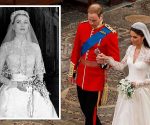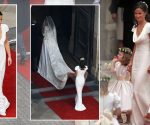Which colours suit YOU? The step by step guide to picking your clothes
[ad_1]
Finding clothes that suit you isn’t just about the style or the fit, it’s also about the colour. You can wear whatever makes you feel good, but chances are you’ll feel incredible in colours that actually bring out your favourite features. Figuring out which colours suit you is quite tricky, but don’t panic. Express.co.uk chatted to ‘One of a Style’ stylist Stefania Bartolomei who specialises in personal shopping, styling masterclasses, wardrobe edits and colour analyses, to find out which colours suit YOU.
The colours that suit us the most are determined by the combination of our natural features such as hair, eyebrow colour, skin tone and undertones, lip colour and eye colour.
Finding out which colours suit you starts with understanding your main characteristics.
Are you light or dark, bright or soft, cool or warm? This might sound really complex, but it’s doable when you know how to work it out.
According to stylist Stefania Bartolomei, all you have to do is answer at least one of the following three questions (being as objective as possible)
READ MORE- Body type test: The simple theory to determine your Kibbe body type
Do I have warm or cool undertones?
There are three tricks that can help work out whether you’ve got warm or cool undertones.
Take a crispy white piece of paper and then put it close to your face, how does your skin look? more yellowish or more pinkish? Yellow usually means warm undertone, while pink should indicate cool undertones.
Look at your wrist veins: are they greenish or blueish? Green veins usually mean you have warm undertones while blue veins indicate you have most luckily cool undertones.
Do you wear silver or gold jewellery? Gold helps to bring out the warm undertone of the skin whereas if silver make your complexion and eyes, your’re a cooler tone.
Cool undertones: Wear colours with blue undertones, such as bright greens, dark purples, pinks and blues.
Warm undertones: Yello based colours such as red, oranges, peaches and golds are right up your street.
Do they have light or dark/deep colouring?
For instance, people with fair skin, blonde hair and blue eyes, undoubtedly have light colours.
People with dark hair, dark eyes and olive skin usually have deep colouring.
Now while this may be a straightforward process it may not be as easy as it sounds for others who have medium colouring – the process can be a bit more complicated.
Do I have high or low contrasts?
This question helps determine the level of saturation usually, people with high contrasts (for instance very light eyes and very dark hair) have a higher level of saturation so look better with brighter colours.
People with very low contrasts (for instance medium/light skin tone, hazel eyes and medium brown hair) usually look better with muted colours as they complement their soft features.
Even in this case, for some people this can be really easy to determine, while for others it can be challenging.
DON’T MISS…
Princess Ingrid of Norway ‘came & conquered’ in ‘beautiful’ picture [INFORMER]
Kate Middleton ‘channels Meghan Markle’ in Massimo Dutti camel coat [INSIGHT]
Horoscopes: How each star sign can ‘get the most out of life’ [EXPLAINER]
The seasons are:
- Autumn – made of deep, warm, and soft (if you think of autumn and the colours of the leaves, you’ll have a hint of which shades belong to this seasons)
- Winter – made of deep, cool and bright colours.
- Spring – which is made of bright, warm and light
- Summer – which is made of light, cool and soft.
The seasons also are divided into three sub-groups to highlight the predominance of one of these values in each person.
Stefania explained: “Three distinct people can fit into the summer season but have quite different colours among them.
“One can be very very light and delicate (think of Cate Blanchett) and look better in pastels, one can have slightly darker and more intense features (think of Emily Blunt) and look better in more intense and blueish shades, and the other can have very soft contrasts and colouring (think of Kate Winslet) and look better in colours predominantly muted.
“This happens for every season, and there are many different personal combinations that make this discipline difficult and challenging.
“But it can also be extremely interesting when done successfully and even life-transforming for many!”
Most people only fit into one category, so you should consult a professional like Stefania if you really want to know but aren’t sure.
The stylist said: “Based on my experience, most people fit into one category, but there can be exceptions. Ageing, for example, often leads to a natural colour alteration and some people can change their colours or even their season throughout life.
“This is especially true for people who in their youth used to have dark hair and bright colouring who then might become lighter and softer with time and their palette of best colours will change accordingly.
“Also, some people may have a mix of features, the so-called “neutral” and pick colours from two different seasons. Those are the most challenging to determine, but once their palette is discovered they’ll have a wider choice.”
There’s one last element that determines what colours you look best in, and it’s not a physical attribute: Confidence! This can allow you to wear colours that aren’t 100 percent right for you, Stefania said.
She explained: “Many people love wearing colours that are not too suitable for them, but they still love them and feel confident when wearing them. The most typical example is black: although it is not suitable for most people, it is one of the most loved.
“I never ask people to stop wearing it, but I do encourage them to ‘fix’ it by wearing it together with some of their power colours through clothing, accessories and make-up, and it makes the world of difference.”
[ad_2]
Source link










